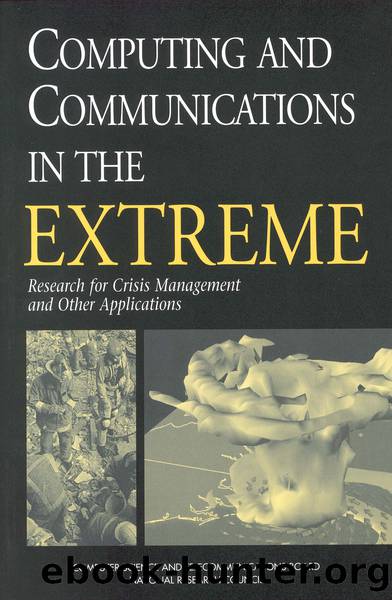Computing and Communications in the Extreme: Research for Crisis Management and Other Applications by Steering Committee Workshop Series on High Performance Computing & Communications

Author:Steering Committee, Workshop Series on High Performance Computing & Communications
Language: eng
Format: epub
Tags: Computers and Information Technology
Publisher: NATIONAL ACADEMY PRESS
Published: 1996-07-12T00:00:00+00:00
Storage Servers and Meta-Data
Crisis management applications employ databases of substantial size. For example, workshop participants estimated that a database of the relevant infrastructure (e.g., utilities, building plans) of Los Angeles requires about 2 terabytes. Not all of it must be handled by any one computer at one time; however, all of it may potentially have to be available through the response organizationâs distributed communications. In addition, a wide variety of data formats and representations occur and must be handled; this may always be the case because of the unpredictability of some needs for data in a crisis. Reformatting data rapidly through services such as those discussed in the section "Information Management" can be computationally intensive and require fast storage media.
Comprehensive provisions must also be made for storing not only data, but collateral information (meta-data) needed to interpret the data. Besides concerns appropriate to all distributed file systems (authentication, authorization, naming, and the like), these involve issues of data validity, quality, and timeliness, all of which are needed for reliable use of the data, and semantic self-description to support integration and interoperability.
To customize information handling for particular applications, storage server software should be able to interpret and respond to the meta-data. Workshop participants suggested that in crisis management, for example, a scheme could be developed to use meta-data to limit the use of scarce bandwidth and to minimize storage media access time while accommodating incoherence of data distributed throughout the response organization. To conserve bandwidth, a central database system located outside the immediate crisis area could maintain a copy of the information stored in each computer at the scene of the crisis. Instead of replicating whole databases across the network when new information alters, contradicts, or extends the information in either copy, a more limited communication could take place to restore coherence between copies or at least provide a more consistent depiction of the situation. A "smart" coherence protocol could relay only changes in the data, or perhaps an executable program to accomplish them. Relevant meta-data for making these determinations might include, for example, time of last update for each data point, so that new data can be identified, and an estimate of quality, to avoid replacing older but "good" data with newer "less good" data.
Besides resource conservation, a beneficial side effect of this coherence scheme would be the creation of a fairly accurate and up-to-date representation of the entire crisis situation, valuable for coordination and decision making. Modeling the coherence and flow of information into, within, and out of the crisis zone could be incorporated into a system that would continuously search for (and perhaps correct) anomalies and inconsistencies in the data. It could also support collaboration and coordination among the people working on a response operation by helping crisis managers know what information other participants have available to them.
Download
This site does not store any files on its server. We only index and link to content provided by other sites. Please contact the content providers to delete copyright contents if any and email us, we'll remove relevant links or contents immediately.
Grails in Action by Glen Smith Peter Ledbrook(9162)
Sass and Compass in Action by Wynn Netherland Nathan Weizenbaum Chris Eppstein Brandon Mathis(8808)
Azure Containers Explained by Wesley Haakman & Richard Hooper(7423)
Configuring Windows Server Hybrid Advanced Services Exam Ref AZ-801 by Chris Gill(7420)
Kotlin in Action by Dmitry Jemerov(7262)
Running Windows Containers on AWS by Marcio Morales(6961)
Microsoft 365 Identity and Services Exam Guide MS-100 by Aaron Guilmette(5388)
Microsoft Cybersecurity Architect Exam Ref SC-100 by Dwayne Natwick(5194)
Combating Crime on the Dark Web by Nearchos Nearchou(4969)
The Ruby Workshop by Akshat Paul Peter Philips Dániel Szabó and Cheyne Wallace(4655)
Management Strategies for the Cloud Revolution: How Cloud Computing Is Transforming Business and Why You Can't Afford to Be Left Behind by Charles Babcock(4521)
Python for Security and Networking - Third Edition by José Manuel Ortega(4226)
The Age of Surveillance Capitalism by Shoshana Zuboff(4207)
Learn Wireshark by Lisa Bock(4096)
The Ultimate Docker Container Book by Schenker Gabriel N.;(3880)
Learn Windows PowerShell in a Month of Lunches by Don Jones(3679)
DevSecOps in Practice with VMware Tanzu by Parth Pandit & Robert Hardt(3558)
Windows Ransomware Detection and Protection by Marius Sandbu(3536)
Blockchain Basics by Daniel Drescher(3495)
